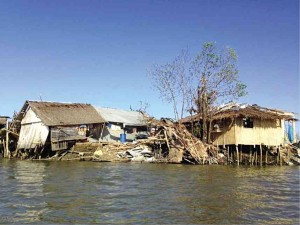In island village, sea offers life after storm

VIEW from the sea of Navitas, an island village in Panay, Capiz that was also hit by Supertyphoon “Yolanda.” MARICAR P. CINCO/INQUIRER SOUTHERN LUZON
PANAY, Capiz—It could be the longest four hours in the lives of residents of the island village of Navitas here, who sought shelter in the ceilings of the village hall and a health center as Supertyphoon “Yolanda” wound its way into the province.
While everyone survived the ordeal, they went home to a place so altered that they could no longer recognize it as their home.
“You wouldn’t be able to say whose house is which,” said fisherman Deovani Buhay, as he picked through piles of wood planks for nails that could be of use to rebuild his hut.
The scene was pretty much the same more than a week after Yolanda hit the coastal community, about an hour by boat from the mainland. Nipa huts leveled, clothes and plastic basins scattered, and fishing boats with outriggers snapped due to the strong winds.
Evacuation
Article continues after this advertisementThe families evacuated to the village hall, about 300 meters from the shoreline, a day before the typhoon.
Article continues after this advertisementBy noon on Nov. 8, the wind was starting to sound like the cries of a million children running in fear and the water was rising to their knees. Afraid that they might drown, the residents peeled open a portion of the ceiling and let their women and children climb in first.
There were about a hundred of them, Buhay said. The other families, who stayed in the adjacent health center, did the same to the ceiling.
“Some peed in their pants out of fear and no one wanted to climb down even after the storm already passed,” Buhay’s wife, Bernadita, said. The Buhays have four daughters.
Like newborns
Help first reached the island three days after the storm when a helicopter, carrying relief goods, flew low over Navitas.
Residents ran to the shoreline and made a gesture of putting a hand to their mouth to signal food.
Buhay said foreign soldiers gave them seven sacks of rice and noodles, which the village chief divided equally to 130 families.
“So far, we have enough supply of food and this vast ocean as our source. We could dig up wells for water,” Buhay said, noting that it is the community’s practice to stash food ahead of typhoons.
The families are starting to rebuild their homes, out of the same materials left of their leveled nipa huts.
“We understand the government also got its hands full but if you could reach them, tell them we need help to fix our boats. What good would come out of the ocean if we couldn’t sail,” he said.
He said a decent hut may cost P30,000 or more as the cost of bamboo poles here tripled to P120 each. His “conservative estimate” to fix a boat was P5,000, something a fisherman could not afford in better times, much less in this situation, he said.
“We would be grateful for materials but you people from Manila might now know what kind of wood we need or fishnets we use,” he said.
Every Christmas, the Buhays looked forward to a reunion with relatives in Parañaque City and Laguna.
But not this year. “No clothes, no home, no boat, we’re like newborn babies with nothing,” Buhay said. “Pass muna sa Pasko. (Let Christmas come and go) I believe the Lord will understand that,” he said.